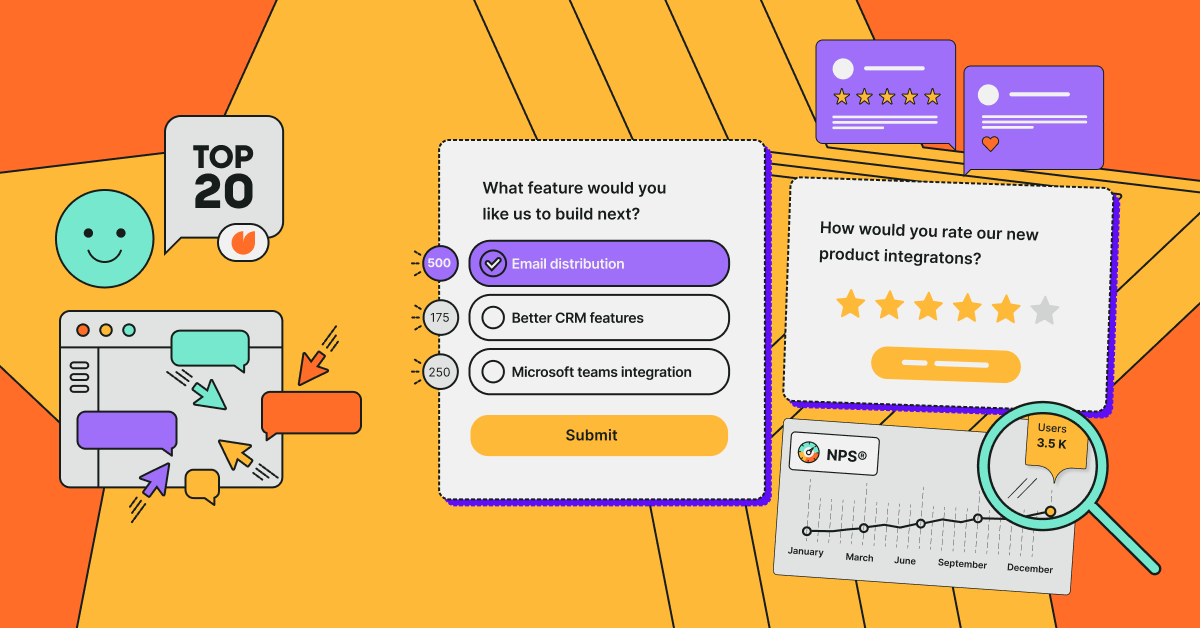Top product feedback tools
Listening to your customers is the key to product success. This definitive guide explores the top tools to capture user feedback seamlessly across devices, analyze it quickly, and enable your team to act on insights.

Listening to your customers is the key to creating successful products that people love. But sifting through and making sense of user feedback can be overwhelming. The right tools are game-changers for gathering actionable insights from your users seamlessly.
With the best product feedback software, you can effortlessly collect user opinions across touchpoints, analyze feedback quickly to uncover trends, and enable your team to implement improvements that customers will notice.
This definitive guide will explore the top-rated tools to turn customer feedback into tangible product success. Whether you're looking to understand user needs, test concepts, monitor reviews, or understand sentiment - we've got you covered.
Key Product Capabilities
- Multi-channel feedback collection
Gathers insights from diverse touchpoints like surveys, in-product, reviews, social media. - Analytics and sentiment analysis
Quantifies and analyzes large volumes of feedback to uncover trends. - Prioritization and roadmapping
Enables mapping feedback to development plans and priorities. - Collaboration features
Provides tools to assign tasks and actions based on insights. - Closing feedback loops
User portals and updates to show customers their input was heard.
Canny

Canny is a user feedback management platform that helps product teams collect, organize and prioritize customer feature requests and feedback. Key capabilities include:
- In-app feedback widgets to gather context-specific insights from users
- Ability to vote and comment on feature requests to identify top priorities
- Roadmapping tools to map feedback to development plans
- Customer portals to engage users and keep them updated
The main value of Canny is its structured approach to gathering meaningful feedback and leveraging it to define high-value product improvements. By enabling users to submit requests and upvote popular ones, Canny surfaces the most important features based on user input. Teams can then easily map top-requested capabilities to their roadmap.
Additionally, Canny improves customer transparency by providing portals and changelog updates on how their feedback is being used. This closes the loop with users and ensures their input is guiding product direction.
Overall, Canny delivers an end-to-end workflow for product teams to efficiently prioritize and action on customer feedback. Its crowdsourced approach and transparency focus make it impactful for building customer-driven roadmaps.
Hotjar

Hotjar is a user experience analytics platform that helps businesses understand how users interact with their website or application. Key features include:
- Session recordings - Watch real user sessions to see struggles first-hand. This identifies usability issues and UX flaws.
- Heatmaps - Visualize clicks, taps and scrolls to see what users care about. Uncover areas that need refinement.
- Surveys - Get feedback directly from users to understand pain points.
- Form analysis - See how users complete forms to optimize flows.
The core value of Hotjar is generating actionable insights by revealing how real users behave. The visual data makes it easy to pinpoint usability problems and identify opportunities to improve conversion rates.
Hotjar provides both qualitative UX feedback through recordings and surveys, as well as quantitative data on user actions through heatmaps and analytics. This combination empowers product teams to truly understand their customer experience.
By enabling companies to rapidly iterate based on user feedback, Hotjar is indispensable for creating intuitive products that fit customer needs. The ability to continuously optimize through user input is why Hotjar is a critical product feedback software.
Sprig

Sprig is a product feedback management platform that consolidates feedback from multiple sources including NPS, CSAT, social media and review sites. It analyzes feedback data using AI and machine learning to surface key insights and trends. Sprig also has collaboration features that allow teams to turn feedback into actionable tasks and development items.
The key value of Sprig is its ability to ingest feedback from diverse sources and identify patterns in the data to uncover improvement opportunities. By centralizing and intelligent analyzing customer feedback data, Sprig provides product teams with a nuanced understanding of customer sentiment and needs. This enables them to continuously refine and optimize their products based on user input and preferences.
Overall, Sprig is an important feedback tool for understanding the customer experience holistically across channels to drive better product decision making.
Typeform

Typeform specializes in creating interactive forms, surveys and quizzes that engage respondents. Key features include:
- Conversational interfaces with chat-like interactions
- Logical branching based on answers
- Built-in analytics and sentiment analysis
- Integration with other tools like Slack and Zendesk
The main benefit of Typeform is the ability to design polished, conversational surveys that feel more like guiding users through an experience vs filling out a form. This drives higher response rates and more thoughtful, qualitative feedback.
Typeform makes it easy to ask follow-up questions based on responses, guiding users to share detailed insights. The platform analyzes unstructured feedback to uncover sentiment patterns and themes.
With Typeform, product teams can craft feedback journeys that walk customers through key questions, uncovering pain points and new feature needs. The analytics provide clear data to identify improvements.
Overall, Typeform delivers an engaging way to collect nuanced product feedback across customer touchpoints. The insights it surfaces help teams continually optimize the product experience.
